Gunung Tapak, also known as Mount Tapak, is one of the lesser-known yet highly accessible volcano hikes located on the island of Bali. This Bali Life will provide you with all the essential information to ensure you have an enjoyable and safe exploration of Tapak.
Located within the Bedugul caldera, Gunung Tapak stands at an elevation of 1,909 meters (6,263 feet) above sea level. While this may sound impressive, it remains one of the easiest and most enjoyable hikes in Bali. In fact, our 6-year-old son and his friend managed to complete it without any prior training and with minimal complaints.
All the peaks in the Bedugul area are classified as “inactive” volcanoes, although there is active geothermal activity in the region. The area itself is the remnant of a once-massive volcano that dwarfed Mount Agung. Notably, there have been no recorded eruptions in this area, despite the fact that the western peaks of Bali are relatively new in geological terms.
Here’s an interesting tidbit: “Tapak” translates directly to “flat.” Therefore, Gunung Tapak essentially means “Flat Mountain” or “Mountain Flat,” a name derived from the relatively flat profile of the mountain’s summit. It’s a quirky fact, but nonetheless fascinating!
The main climbing trail begins in the Botanical Gardens, making it one of the best-maintained hiking paths in Bali and a delightful experience. On weekdays, you might encounter a young man who is employed by the Botanical Gardens to help keep the trail clean. I often like to give him a tip ranging from 10k to 100k while pointing at the trail and saying “Bagus” (Good!). The surprise and joy on his face make it worthwhile.
Several routes are available for hiking, and most will take you through the unbelievably beautiful Botanical Gardens, which could be a highlight on any day.
However, it’s essential to note that this hike does not offer the breathtaking views that hikes to Agung, Abang, and Batur provide. Most of the climb is beneath a thick canopy of trees, where panoramic views are limited. The lush vegetation is both fascinating and exotic, and for many, this alone is enough to love the journey. Just before reaching the summit, there is a clearing offering expansive views across northwestern Bali, contingent upon clear weather conditions. If luck is on your side with a bright day, the sight can be spectacular, but it cannot be guaranteed.
The trail is steep, and if you’re not accustomed to climbing volcanoes in Indonesia, it can be a bit of a challenge. Unlike many European or American trails, which often have switchbacks and winding paths to ease the gradient, the trails on these Balinese volcanoes tend to go straight up, as if someone had drawn a direct line from the base to the summit. It often feels like ascending a steep, slippery staircase littered with mud. You’ll come to enjoy the thrill of it.
Fortunately, Gunung Tapak’s trail is meticulously maintained, so even the slippery sections are well-roped, and much of the route feels like a well-designed muddy staircase, thanks to the careful placement of roots and logs that make the climb enjoyable.
How accessible is it?
When I mention accessibility, I do not imply that the hike accommodates those with disabilities. Instead, I mean that compared to some of Bali’s wilder and more challenging paths, Gunung Tapak is one of the easiest and best-kept trails available.
If you have specific access needs, check our list of things to do in Bali for more suitable options.
If you have young children around 5 or 6 years old, they should be able to manage the climb up Gunung Tapak. Even if you’re out of shape but determined, you should find it doable. While it isn’t easy—none of Bali’s volcano hikes are—it promises to be a fun adventure.
Botanical Gardens
As previously mentioned, Gunung Tapak is located within Bali’s Botanical Gardens, officially known as Kebun Raya Bali. This prominent garden, situated in Bedugul, Tabanan Regency, spans approximately 157 hectares, making it the largest botanical garden in Indonesia.
The garden boasts a diverse collection of flora from across the Indonesian archipelago, including rare and endangered species. Visitors can explore various themed areas, such as the Orchid Garden, Fern Garden, and Medicinal Plant Garden. The garden is also home to an impressive collection of orchids, a serene lake, and breathtaking views of the surrounding mountains.
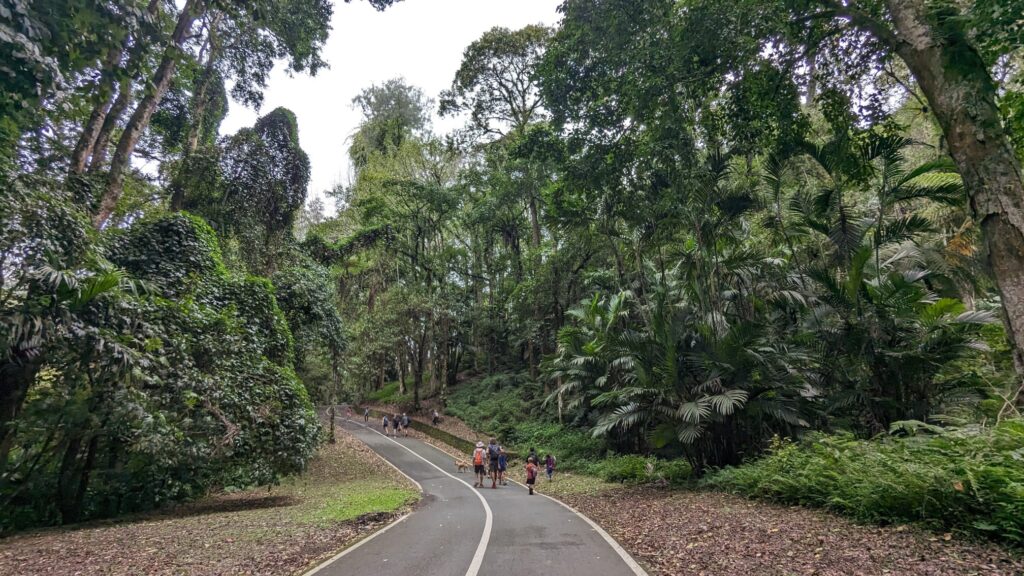
Even if hiking up Gunung Tapak is not on your agenda, you can still enjoy leisurely walks, guided tours, and educational programs within the gardens. Facilities for picnics and recreational activities are also available. Plus, you have the option to rent electric bikes or scooters for a self-guided tour—fun for everyone!
The Bali Botanic Garden plays a crucial role in conserving Indonesia’s plant biodiversity, particularly focusing on rare and endemic species. It is actively involved in research, conservation, and educational programs that promote environmental awareness and sustainability.
Wildlife on Gunung Tapak
While trekking on Gunung Tapak, you may come across various wildlife, including leeches, macaque monkeys, and rats. To ensure a safe and enjoyable experience, proper preparation is key. Wearing suitable clothing, such as long pants tucked into socks and closed-toe shoes, can help prevent leech bites. Additionally, applying insect repellent can deter leeches and other biting insects.
Leeches can be quite sneaky and unappealing. Once they latch on, they tend to hide, and I have found one under my watch before. They often attempt to crawl into your socks, so it’s essential to remain vigilant. Although they are harmless, they can be unpleasant.
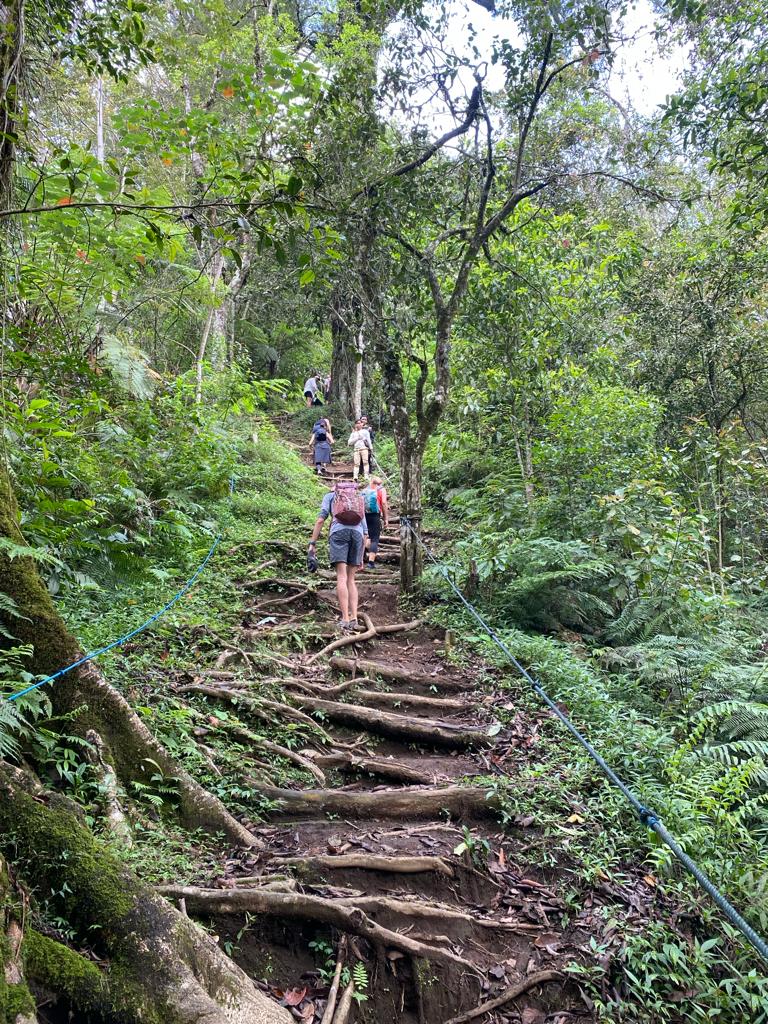
When it comes to macaque monkeys, it’s essential to keep a respectful distance and refrain from feeding or agitating them. Store any food or snacks securely to minimize the chance of attracting their attention. If a monkey approaches you, stay calm, avoid direct eye contact, and slowly back away to give the monkey the space it needs to retreat.
As for the rats, they are usually more active at night but may be attracted to food scraps or improperly stored items. However, if you’re not staying overnight at the summit, you are unlikely to encounter them, as they typically keep to themselves.
In summary, being aware of your surroundings, respecting wildlife, and taking preventative measures can greatly enhance your experience while trekking on Gunung Tapak.
What to Wear and What to Bring for Climbing Gunung Tapak
Dress in sporty attire and opt for suitable hiking or running shoes. Personally, I wear shorts and a t-shirt along with reliable trail running shoes (the Salomon Pulsar, if you’re interested). Some hikers prefer long sleeves for added protection against insects and leeches, but I generally choose to flick them off as soon as I spot them.
For footwear, think about the downhill portions, which often pose the real challenge. Opt for shoes that fit well but allow for a bit of extra space; going a size up is usually a good idea. Based on my experience, rugged shoes outperform delicate options when it comes to hiking. While Gunung Tapak is manageable, the more demanding climbs in Bali necessitate well-chosen footwear.
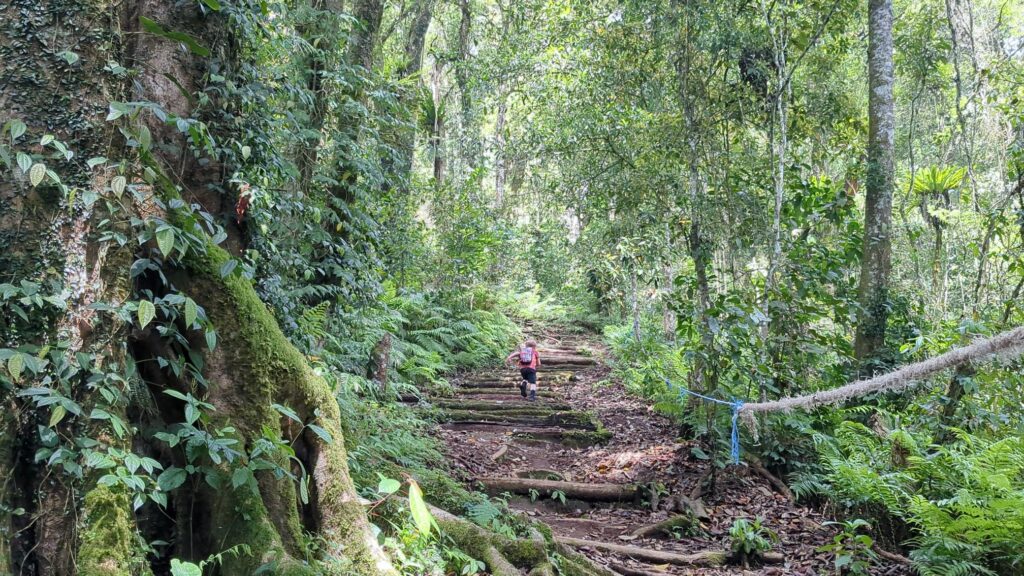
Be sure to trim your toenails before the hike; long toenails can result in painful bruising as they press into your footwear for hours. Trust me—this is advice you’ll want to heed!
Since the trail tends to be more muddy than rocky and the climate is humid within the forest, be prepared for that as well.
In general, here’s a standard list of items I recommend bringing when hiking volcanoes in Bali:
- Route map on your phone – essential for ensuring you stay on the main trail
- Plenty of water – it’s better to carry extra than to run short; I recommend at least 1.5 liters per person for Gunung Tapak.
- Snacks – high-calorie options like nuts or protein bars work well (salty treats are also a good choice).
- Light waterproof jacket – for obvious reasons
- Sunscreen
- Insect repellent
- Some cash
- Hat or cap (optional)
- Hiking poles (optional)
My top tip? Consider bringing sandals or flip-flops along with a spare t-shirt to change into right after the hike. You’ll be grateful for the comfort of slipping into sandals after hiking Gunung Tapak. Just keep them in your vehicle, as your bag is likely to get soaked from humidity, foliage, and sweat.
Guidelines to Follow While Hiking on Bali’s Volcanoes
Tourists have unfortunately earned a negative reputation across Bali. Whether it’s due to someone disrupting the peace on Agung or an influencer disrespecting sacred natural sites, locals often feel that tourists prioritize their whims over nature’s sanctity. Thus, it’s vital for us to do better.
Here are some basic rules to keep in mind while hiking Gunung Tapak:
- Keep your clothes on—it’s really not that difficult!
- Leave no trace—take everything home, even biodegradable scraps like apple cores.
- Avoid reckless behavior—volcanoes can be dangerous, and accidents happen. Stick to the designated paths.
- Verify guidelines regarding guides—certain mountains, like Batur, necessitate the presence of a guide.
- Check for any necessary entrance fees—this isn’t always obvious.
- Show respect—each peak in Bali features a temple at the base where hikers should seek the blessings of local spirits and gods, as well as a temple at the summit. The Balinese people have a profound connection to their spirituality, so treat these sites with due reverence.
- If you need to pass through a temple, be sure to wear appropriate attire.
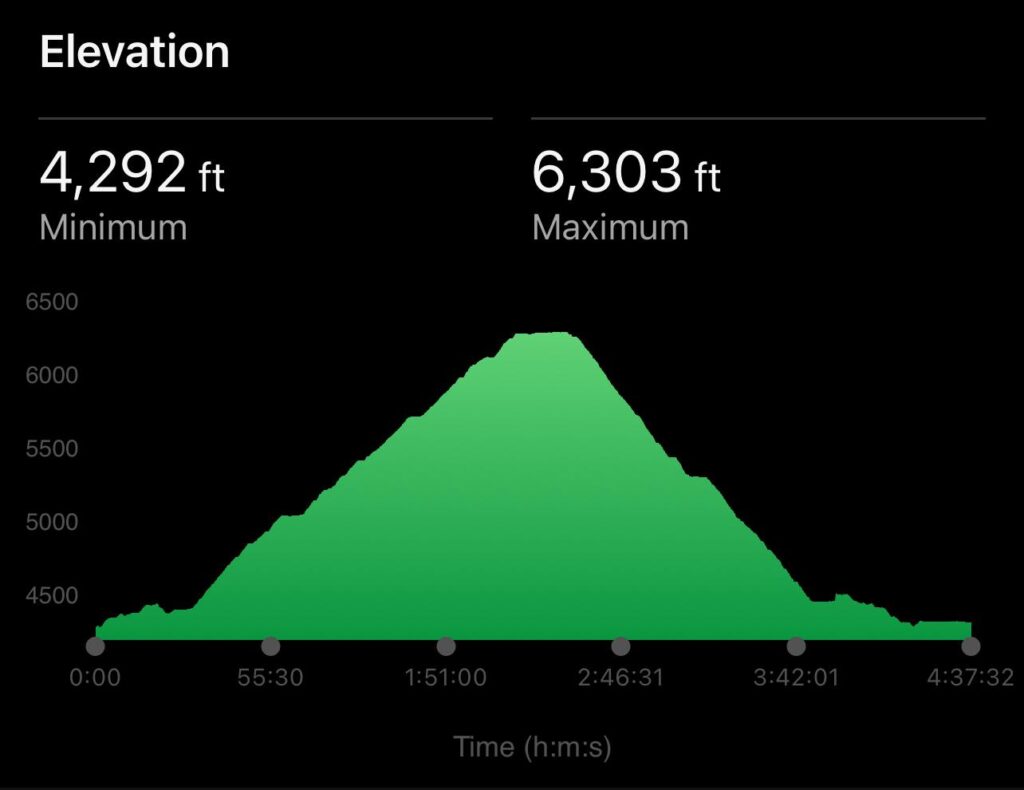
Which Route to Take Up Gunung Tapak?
There are two primary routes I am familiar with, and a third option that I haven’t experienced yet, which is more of a loop. Once I explore it, I’ll return to provide my insights. For now, I’ll focus on the two trails I know.
Choose according to your preference and the distance you wish to cover:
Route 1 – The Climb from the Botanical Gardens
Difficulty: Easy/Medium - 4km + 550m elevation
This route is the main climbing path for Gunung Tapak and is ideal if you plan to spend the day in the Botanical Gardens.
START POINT: [Link to the start point on Google Maps]
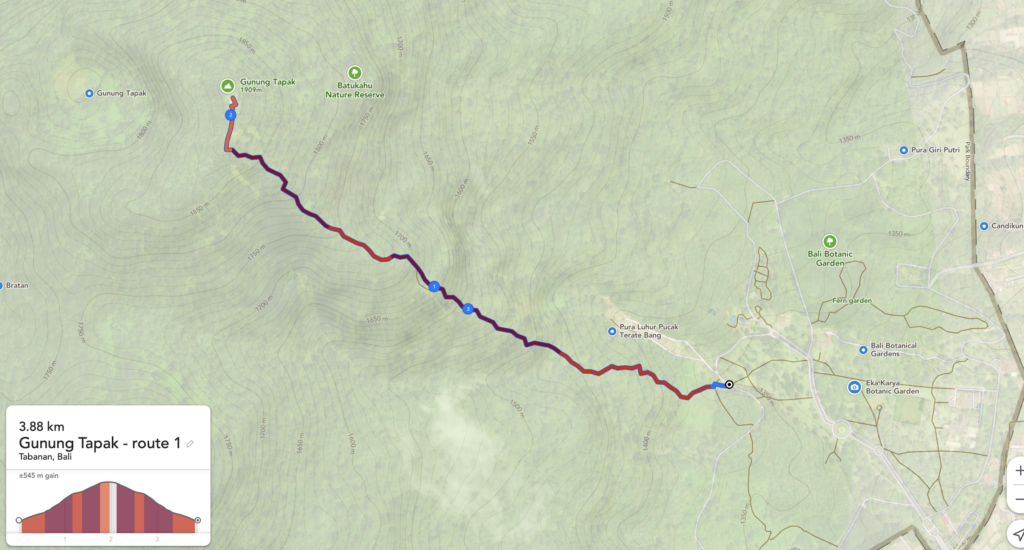
This route is quite straightforward. Start at the designated point and follow the well-maintained path up Gunung Tapak. It’s hard to get lost, as the trail is clearly marked. Occasionally, you may encounter forks in the path, but they eventually loop back together further along.
When descending, just remember to take the left route to return the way you came.
[Link to an interactive map of Gunung Tapak route 1]
Route 2 – Out and Back from Kampung Bingo
Difficulty: Medium/Easy - 8km + 630m vertical
As of today’s writing, Kampung Bingo is closed for renovations but is expected to reopen in October 2024. However, you should still be able to use their parking lot to begin your hike. There will usually be someone available to ask if you can park there, and they are typically very accommodating. I habitually stop by at the end of my hike for a refreshing drink or meal.
START POINT: Start Point at Kampung Bingo
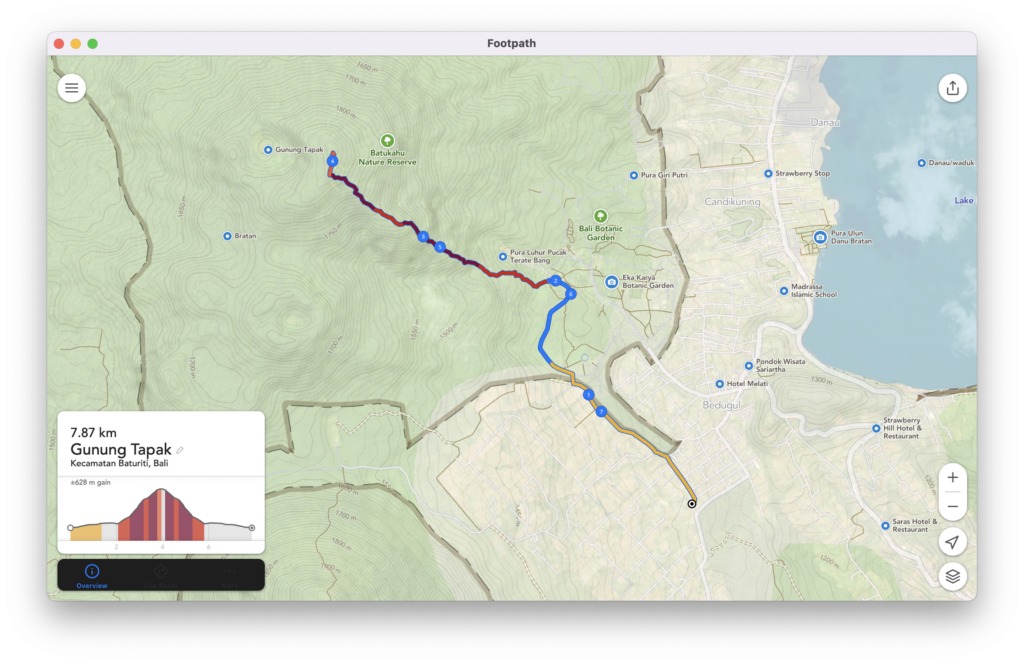
Having the GPX file on your phone is helpful for this route up Gunung Tapak, particularly for navigating the approach.
[Link to interactive map of Gunung Tapak route 2]
When you exit the Kampung Bingo parking lot, turn left and follow the path until it meets the main road. Turn left again on the main road, walking a short distance (less than 100 meters) until you can turn right onto a farm track.
At this point, you should have a wall on your right. Behind the wall lies the Botanical Gardens. Follow the path alongside the wall, up the hill, and across a somewhat dilapidated bamboo bridge until you reach a doorway-sized gap in the wall (this is not merely a hole; it is a proper entrance).
Step through this entrance into the Botanical Gardens, turn left on the path, and follow it until you reach the start of the climb. Without a guide or GPS, it is easy to miss the trail’s beginning. Continue your climb as you would on Route 1.
Once you reach the summit, return the same way. If you wish to spend time exploring the Botanical Gardens afterward, be sure to purchase a ticket; it’s quite affordable.



